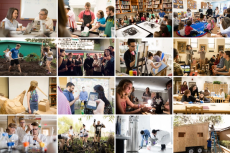Cool Class: Applied Design Solutions
Hammers in hand, Rollins students are exploring big concepts by building a tiny house.
April 11, 2019

Tumbleweed Salsa Box. The name might sound like a fiery entree at a dusty border cantina, but it’s actually the make and model of a 96-square-foot tiny house under construction on the Rollins campus.
Every Saturday morning this spring, 17 students in studio art professor Joshua Almond’s Rollins Foundations in the Liberal Arts (rFLA) capstone course Applied Design Solutions gathered outside the Cornell Fine Arts Museum to assemble their micro masterpiece, all the while meeting twice a week to study issues of sustainability, affordable housing, and climate change. Think of it as a hands-on way to spice up the liberal arts with practical life skills.

Instructor
Joshua Almond, associate professor of art


The Scoop
Apart from watching tutorial videos and consulting outside experts to ensure everything is up to code, Rollins students are doing all the work themselves. Right beside them is art professor Joshua Almond, a former contractor and volunteer with Habitat for Humanity.
“There are two or three in the class who have made things before,” says Almond, “but none have experience building houses or doing anything related to electricity or plumbing. Teaching them how to hammer in two-by-fours, drill screws, and wiring basic electrical outlets—these are good, common-sense things to know how to do around your house. But the learning curve is fairly steep.”
In addition to building the actual house, students are using 3-D modeling software to rapid-prototype a tiny home of their own design.


“I didn’t put many parameters on this part of the project,” says Almond, “so some of them are getting really wild with their designs. But all are giving consideration to sustainability and affordability. That’s kind of the nature of the class.”
Upon completion in early May, the tiny house will either be sold, donated to charity, or installed on campus for students to experience in some form. Either way, says Almond, he wants to keep the momentum going, perhaps even building one of the students’ designs in semesters to come.


Snapshot
We dropped in on the class just as they were putting down the last of the donuts and picking up their staple guns on a beautiful Saturday spring morning. The students spent about four hours weatherproofing the tiny house with Everbilt wrap, a micro-perforated weather-resistant barrier that goes underneath the siding to block air transfer and helps the homeowner save on heating and cooling costs. Next up: window installation.



Student Perspective
Studio art major Christine Cole ’20 appreciates how the course’s hands-on nature helps her learn skills and trades that can be applied outside the classroom.
“This class allows us to discuss big concepts like homelessness and sustainability,” she says, “while also teaching us how to hammer a nail into wood, how to downsize our material possessions, and how to digitally render buildings.”
Did You Know?
Tiny homes, which typically range from 96 to 400 square feet, come in all shapes and styles. Rollins’ version, mounted to an 8-by-12-foot trailer, features a kitchen, shower, compostable toilet, loft bed, couch/futon, and porch overhang with a living garden. To meet code, the weight cannot exceed 10,000 pounds.
- Categories:
- Studio Art |
- Rollins Foundations in the Liberal Arts |
- Cool Classes |
- Academics

Recent Stories
December 18, 2025
What It’s Like … to Reclaim Rollins History Through Theatre
Through yearlong research and close faculty collaboration, Rollins students honored Zora Neale Hurston’s legacy with Let the People Sing, an original documentary drama that blends history, music, and storytelling.
December 16, 2025
From Rollins to Broadway
Juan Carlos ’23, who plays Bob Newby in the Broadway production of Stranger Things: The First Shadow, returned to campus to share what he’s learned on his journey from Rollins to theatre’s biggest stage.
December 15, 2025
Video: Rollins College Sneak Peek
From lakeside classrooms to vibrant student spaces, see where curiosity, community, and opportunity come together.

